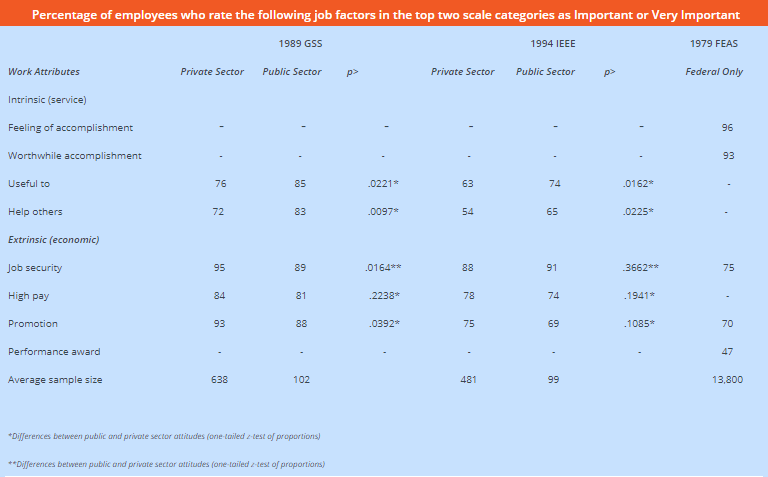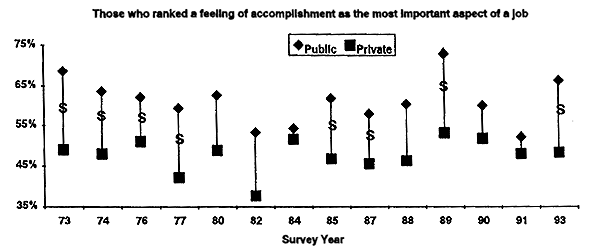The loosely guarded secret shared by almost all government workers is they truly want to make their communities a better place to live.
For the vast majority of those working in government agencies of all descriptions, this is an intrinsic truth. Quite simply, our public servants want to make a difference. For the vast majority, it is what has drawn them to public service in the first place.
A definitive 1997 study on Public Service Motivation, Building Empirical Evidence of Incidence and Effect, corroborates this motivation demonstrating that public sector employees place greater value on helping others and being useful to society AND lesser value on job security and promotions, than those in the private sector.


Source: Public Service Motivation: Building Empirical Evidence of Incidence and Effect (1997)
For critics of government, including, in all honesty, many taxpayers, these truths fly in the face of many of the traditional stereotypes that have manifested over the years regarding government workers:
In terms of the ‘unhappy’ stereotype, there is recent data to support this assertion with a 2016 Gallup Survey of state and local government employees in 43 of 50 states confirming that 71 percent of the work force surveyed was “disengaged” or unenthusiastic about their jobs–and unwilling or incapable of improving their output.
However, as a 2014 study on The Motivational Bases of Public Service revealed, public sector employees do in fact experience greater task significance and job challenge from opportunities to address important social issues. More importantly, research participants reported significantly higher levels of motivation, interaction and performance within a described culture of “transformational leadership.”
These findings jibe with a 2014 Report from the Partnership for Public Service, an organization that has produced numerous reports in the study of public employee engagement, confirming that public sector employees are more productive and feel more connected to their jobs in departments and agencies that are well managed and encouraging of employee initiative.
In short, while public service work provides opportunities to achieve altruistic goals and attracts workers highly invested in these pursuits, it is the very structure of these organizations that often hinders the realization of such aims and acts as a core contributor to overall employee disengagement and unhappiness.
Drilling down into the reams of studies devoted to analysis of public sector employee engagement, motivation, leadership, and performance science, a clearer picture begins to emerge of the core contributing factors that impede government agencies from more effectively leveraging the ambitions of an altruistically focused workforce.
The good news is things are improving. As shown, data derived from a multitude of public employee engagement studies is now identifying key causal factors common to systemic employee disengagement issues, and more importantly, research is now leading the way towards two key solutions to these problems—empowerment and innovation.
In recognizing the hugely positive altruistic temperament of their workforces, government leaders are increasingly deciding that agency environments must be transformed to take advantage of these innate and powerfully motivational character traits. This trend will only escalate as social cause-driven Millennials increasingly ascend to leadership roles within public agencies.
Key to this transformation for government leaders is the ability to equip their staffs with agile technologies empowering true data accessibility and workflow efficiencies which in turn can be leveraged to deliver winning user experiences and improved citizen engagement.
Government workers want to make their world a better place to live. And soon, very soon in fact, they’ll have the right environment and tools to do exactly that.
Looking for more information? Subscribe to our CX blog below to stay in the loop on the latest news, best practices and emerging trends in government technology.